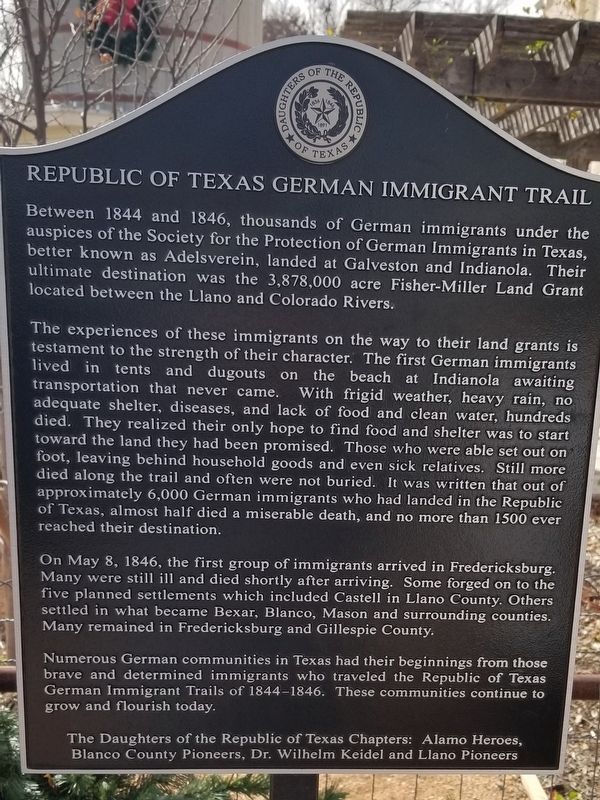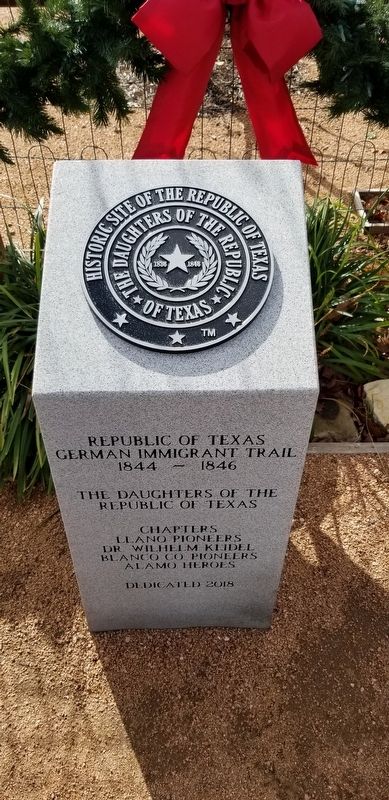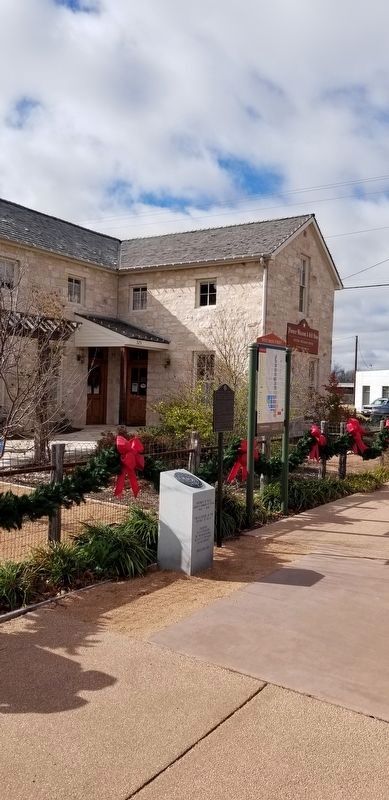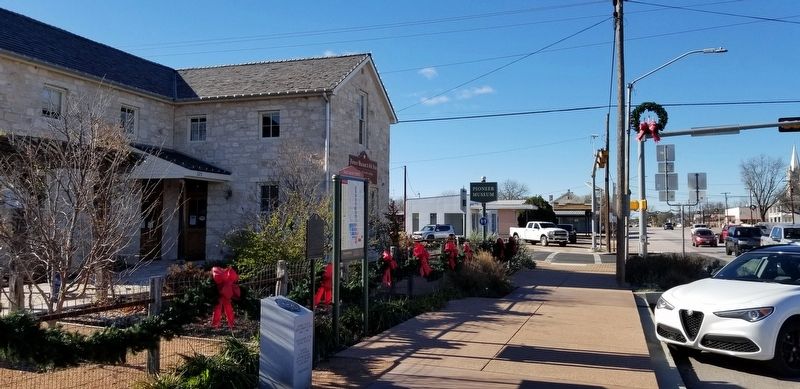Fredericksburg in Gillespie County, Texas — The American South (West South Central)
Republic of Texas German Immigrant Trail
Between 1844 and 1846, thousands of German immigrants under the auspices of the Society for the Protection of German Immigrants in Texas, better known as Adelsverein, landed at Galveston and Indianola. Their ultimate destination was the 3,878,000 acre Fisher-Miller Land Grant located between the Llano and Colorado Rivers.
The experiences of these immigrants on the way to their land grants is testament to the strength of their character. The first German immigrants lived in tents and dugouts on the beach at Indianola awaiting transportation that never came. With frigid weather, heavy rain, no adequate shelter, diseases, and lack of food and clean water, hundreds died. They realized their only hope to find food and shelter was to start toward the land they had been promised. Those who were able set out on foot, leaving behind household goods and even sick relatives. Still more died along the trail and often were not buried. It was written that out of approximately 6,000 German immigrants who had landed in the Republic of Texas, almost half died a miserable death, and no more than 1500 ever reached their destination.
On May 8, 1846, the first group of immigrants arrived in Fredericksburg Many were still ill and died shortly after arriving. Some forged on to the five planned settlements which included Castell in Llano County. Others settled in what became Bexar, Blanco. Mason and surrounding counties. Many remained in Fredericksburg and Gillespie County.
Numerous German communities in Texas had their beginnings from those brave and determined immigrants who traveled the Republic of Texas German Immigrant Trails of 1844-1846. These communities continue to grow and flourish today.
The Daughters of the Republic of Texas Chapters: Alamo Heroes, Blanco County Pioneers, Dr. Wilhelm Keidel and Llano Pioneers
Erected 2018 by Daughters of the Republic of Texas.
Topics. This historical marker is listed in this topic list: Settlements & Settlers. A significant historical date for this entry is May 8, 1846.
Location. 30° 16.71′ N, 98° 52.636′ W. Marker is in Fredericksburg, Texas, in Gillespie County. Marker is at the intersection of West Main Street (U.S. 290) and South Milam Street, on the left when traveling west on West Main Street. The marker is located at the entrance to the Pioneer Museum. Touch for map. Marker is at or near this postal address: 325 West Main Street, Fredericksburg TX 78624, United States of America. Touch for directions.
Other nearby markers. At least 8 other markers are within walking distance of this marker. Sunday Houses (within shouting distance of this marker); Old Kammlah House (about 300 feet away, measured in a direct line); Meckel - Hanus Building (about 400 feet away); First Methodist Church
(about 400 feet away); Gun Cap Factory (about 400 feet away); St. Mary's Catholic Church (about 600 feet away); Hoerster Building (about 600 feet away); Old St. Mary's Church (Die Alte Kirche) (about 700 feet away). Touch for a list and map of all markers in Fredericksburg.
Also see . . .
1. Germans. The largest ethnic group in Texas derived directly from Europe was persons of German birth or descent. As early as 1850, they constituted more than 5 percent of the total Texas population, a proportion that remained constant through the remainder of the nineteenth century. Source: The Handbook of Texas (Submitted on January 3, 2021, by James Hulse of Medina, Texas.)
2. Adelsverein. The society represents a significant effort to establish a new Germany on Texas soil by means of an organized mass emigration. Source: The Handbook of Texas (Submitted on January 3, 2021, by James Hulse of Medina, Texas.)
3. Fisher-Miller Land Grant. The Fisher-Miller Land Grant, made by the Republic of Texas on June 7, 1842, and renewed on September 1, 1843, resulted from a petition made by Henry Francis Fisher, Burchard Miller, and Joseph
Baker on February 8, 1842, to be permitted to settle 1,000 immigrant families of German, Dutch, Swiss, Danish, Swedish, and Norwegian ancestry in Texas under the auspices of the San Saba Colonization Company. Source: The Handbook of Texas (Submitted on January 3, 2021, by James Hulse of Medina, Texas.)
Credits. This page was last revised on January 3, 2021. It was originally submitted on January 3, 2021, by James Hulse of Medina, Texas. This page has been viewed 656 times since then and 90 times this year. Photos: 1, 2, 3, 4. submitted on January 3, 2021, by James Hulse of Medina, Texas. • J. Makali Bruton was the editor who published this page.



